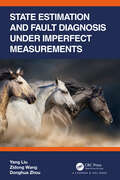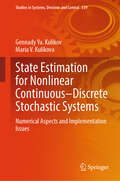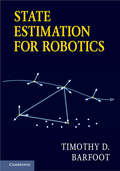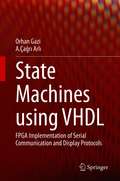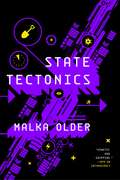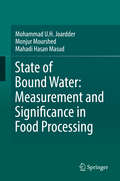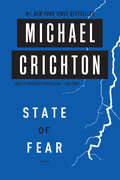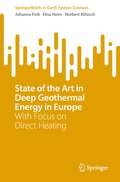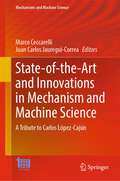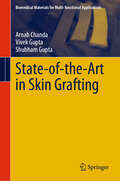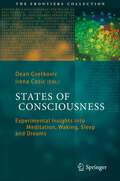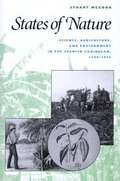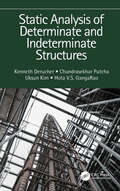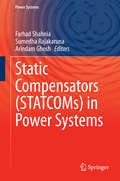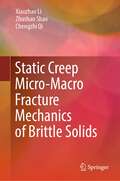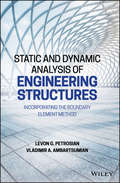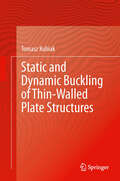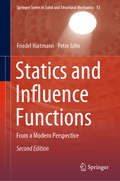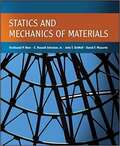- Table View
- List View
State Estimation and Fault Diagnosis under Imperfect Measurements
by Zidong Wang Yang Liu Donghua ZhouThe objective of this book is to present the up-to-date research developments and novel methodologies on state estimation and fault diagnosis (FD) techniques for a class of complex systems subject to closed-loop control, nonlinearities, and stochastic phenomena. It covers state estimation design methodologies and FD unit design methodologies including framework of optimal filter and FD unit design, robust filter and FD unit design, stability, and performance analysis for the considered systems subject to various kinds of complex factors. Features: Reviews latest research results on the state estimation and fault diagnosis issues. Presents comprehensive framework constituted for systems under imperfect measurements. Includes quantitative performance analyses to solve problems in practical situations. Provides simulation examples extracted from practical engineering scenarios. Discusses proper and novel techniques such as the Carleman approximation and completing the square method is employed to solve the mathematical problems. This book aims at Graduate students, Professionals and Researchers in Control Science and Application, Stochastic Process, Fault Diagnosis, and Instrumentation and Measurement.
State Estimation and Stabilization of Nonlinear Systems: Theory and Applications (Studies in Systems, Decision and Control #491)
by Mohamed Ali Hammami Omar Naifar Abdellatif Ben MakhloufThis book presents the separation principle which is also known as the principle of separation of estimation and control and states that, under certain assumptions, the problem of designing an optimal feedback controller for a stochastic system can be solved by designing an optimal observer for the system's state, which feeds into an optimal deterministic controller for the system. Thus, the problem may be divided into two halves, which simplifies its design. In the context of deterministic linear systems, the first instance of this principle is that if a stable observer and stable state feedback are built for a linear time-invariant system (LTI system hereafter), then the combined observer and feedback are stable. The separation principle does not true for nonlinear systems in general. Another instance of the separation principle occurs in the context of linear stochastic systems, namely that an optimum state feedback controller intended to minimize a quadratic cost is optimal for the stochastic control problem with output measurements. The ideal solution consists of a Kalman filter and a linear-quadratic regulator when both process and observation noise are Gaussian. The term for this is linear-quadratic-Gaussian control. More generally, given acceptable conditions and when the noise is a martingale (with potential leaps), a separation principle, also known as the separation principle in stochastic control, applies when the noise is a martingale (with possible jumps).
State Estimation for Nonlinear Continuous–Discrete Stochastic Systems: Numerical Aspects and Implementation Issues (Studies in Systems, Decision and Control #539)
by Gennady Yu. Kulikov Maria V. KulikovaThis book addresses the problem of accurate state estimation in nonlinear continuous-time stochastic models with additive noise and discrete measurements. Its main focus is on numerical aspects of computation of the expectation and covariance in Kalman-like filters rather than on statistical properties determining a model of the system state. Nevertheless, it provides the sound theoretical background and covers all contemporary state estimation techniques beginning at the celebrated Kalman filter, including its versions extended to nonlinear stochastic models, and till the most advanced universal Gaussian filters with deterministically sampled mean and covariance. In particular, the authors demonstrate that, when applying such filtering procedures to stochastic models with strong nonlinearities, the use of adaptive ordinary differential equation solvers with automatic local and global error control facilities allows the discretization error—and consequently the state estimation error—to be reduced considerably. For achieving that, the variable-stepsize methods with automatic error regulation and stepsize selection mechanisms are applied to treating moment differential equations arisen. The implemented discretization error reduction makes the self-adaptive nonlinear Gaussian filtering algorithms more suitable for application and leads to the novel notion of accurate state estimation. The book also discusses accurate state estimation in mathematical models with sparse measurements. Of special interest in this regard, it provides a means for treating stiff stochastic systems, which often encountered in applied science and engineering, being exemplified by the Van der Pol oscillator in electrical engineering and the Oregonator model of chemical kinetics. Square-root implementations of all Kalman-like filters considered and explored in this book for state estimation in Ill-conditioned continuous–discrete stochastic systems attract the authors’ particular attention. This book covers both theoretical and applied aspects of numerical integration methods, including the concepts of approximation, convergence, stiffness as well as of local and global errors, suitably for applied scientists and engineers. Such methods serve as a basis for the development of accurate continuous–discrete extended, unscented, cubature and many other Kalman filtering algorithms, including the universal Gaussian methods with deterministically sampled expectation and covariance as well as their mixed-type versions. The state estimation procedures in this book are presented in the fashion of complete pseudo-codes, which are ready for implementation and use in MATLAB® or in any other computation platform. These are examined numerically and shown to outperform traditional variants of the Kalman-like filters in practical prediction/filtering tasks, including state estimations of stiff and/or ill-conditioned continuous–discrete nonlinear stochastic systems.
State Estimation for Robotics
by Timothy D. BarfootA key aspect of robotics today is estimating the state, such as position and orientation, of a robot as it moves through the world. Most robots and autonomous vehicles depend on noisy data from sensors such as cameras or laser rangefinders to navigate in a three-dimensional world. This book presents common sensor models and practical advice on how to carry out state estimation for rotations and other state variables. It covers both classical state estimation methods such as the Kalman filter, as well as important modern topics such as batch estimation, the Bayes filter, sigmapoint and particle filters, robust estimation for outlier rejection, and continuous-time trajectory estimation and its connection to Gaussian-process regression. The methods are demonstrated in the context of important applications such as point-cloud alignment, pose-graph relaxation, bundle adjustment, and simultaneous localization and mapping. Students and practitioners of robotics alike will find this a valuable resource.
State Machines using VHDL: FPGA Implementation of Serial Communication and Display Protocols
by Orhan Gazi A.Çağrı ArlıThis textbook teaches students techniques for the design of advanced digital systems using Field Programmable Gate Arrays (FPGAs). The authors focus on communication between FPGAs and peripheral devices (such as EEPROM, analog-to-digital converters, sensors, digital-to-analog converters, displays etc.) and in particular state machines and timed state machines for the implementation of serial communication protocols, such as UART, SPI, I²C, and display protocols, such as VGA, HDMI. VHDL is used as the programming language and all topics are covered in a structured, step-by-step manner.
State Tectonics (The Centenal Cycle #3)
by Malka OlderCampbell Award finalist Malka Older's State Tectonics concludes The Centenal Cycle, the cyberpunk poltical thriller series that began with Infomocracy.The future of democracy must evolve or die.The last time Information held an election, a global network outage, two counts of sabotage by major world governments, and a devastating earthquake almost shook micro-democracy apart. Five years later, it's time to vote again, and the system that has ensured global peace for 25 years is more vulnerable than ever. Unknown enemies are attacking Information's network infrastructure. Spies, former superpowers, and revolutionaries sharpen their knives in the shadows. And Information's best agents question whether the data monopoly they've served all their lives is worth saving, or whether it's time to burn the world down and start anew.The Centenal Cycle#1 Infomocracy#2 Null States#3 State TectonicsAt the Publisher's request, this title is being sold without Digital Rights Management Software (DRM) applied.
State of Bound Water: Measurement and Significance in Food Processing
by Mohammad U.H. Joardder Monjur Mourshed Mehedi Hasan MasudThis book presents a comprehensive review of the characteristics of bound water and its use in food processing. The significance of bound water in food is discussed in terms of quality, energy consumption and cost. Also included is a thorough discussion on the emerging and appropriate measuring techniques of bound water in food materials. The challenges involved with bound water measurement and strategies for bound water removal during processing are covered in order to establish the appropriate conditions for food preservation. This work presents researchers with a clear, up-to-date concept of bound water and its significance in food processing and preservation. Despite the importance of bound water in food processing, there are limited resources for researchers seeking an in-depth understanding of bound water in food materials. This is the first reference work dedicated to discussing the details of bound water in food materials and its significance in food processes and preservation, from its special characteristics to its energy consumption to its measurement and techniques. State of Bound Water: Measurement and significance in food processing is a singular work in the field of food preservation and processing arena.
State of Fear
by Michael CrichtonIn Paris, a physicist dies after performing a laboratory experiment for a beautiful visitor. In the jungles of Malaysia, a mysterious buyer purchases deadly cavitation technology, built to his specifications. <P><P>In Vancouver, a small research submarine is leased for use in the waters off New Guinea.And in Tokyo, an intelligence agent tries to understand what it all means. <P><P>Thus begins Michael Crichton's exciting and provocative technothriller, State of Fear. Only Michael Crichton's unique ability to blend science fact and pulse-pounding fiction could bring such disparate elements to a heart-stopping conclusion. This is Michael Crichton's most wide-ranging thriller. <P><P>State of Fear takes the reader from the glaciers of Iceland to the volcanoes of Antarctica, from the Arizona desert to the deadly jungles of the Solomon Islands, from the streets of Paris to the beaches of Los Angeles. The novel races forward, taking the reader on a rollercoaster thrill ride, all the while keeping the brain in high gear. Gripping and thought-provoking, State of Fear is Michael Crichton at his very best.
State of the Art in Deep Geothermal Energy in Europe: With Focus on Direct Heating (SpringerBriefs in Earth System Sciences)
by Johanna Fink Elisa Heim Norbert KlitzschSince nearly 50 % of Europe's energy demand is in the heating and cooling sector, it is expected that geothermal energy will play an important role in the transition to a decarbonized energy system. However, deep geothermal energy is currently harvested mainly from areas with very favorable geothermal conditions. As these areas are geographically limited, the use of geothermal energy in less favorable regions is essential for unleashing the full potential of geothermal energy, since they make up the majority of the total geothermal potential in Central Europe. Motivated by the growing interest in deep geothermal energy among, e.g., energy companies and communities, this text reviews the state of the art in deep geothermal energy with focus on direct heating in geothermally less favorable regions. It provides an overview of technologies used to generate heat from the deep underground and discusses main technical and non-technical risks associated with deep geothermal projects. The text addresses readers with an interest in geothermal energy but does not require a background in geoscience or engineering sciences. It is suitable as textbook for Geothermal Energy courses for undergraduate students from different disciplines.
State-Level Changes in Energy Intensity and Their National Implications
by Mark A. Bernstein Sam Loeb David S. Loughran Katya FonkychThe 2001 National Energy Policy calls for continued reductions in energy intensity (energy consumption per dollar of gross economic output). This study was part of an effort to identify state-level factors that may contribute to efficient energy use nationwide. The authors examined changes in energy intensity in 48 states and in the states' energy-consuming sectors from 1977 through 1999. Some factors that may explain differences in states' energy intensity are energy prices, new construction, capacity utilization, population, climate, tech innovations, and government energy policies.
State-of-the-Art Upcycling Research and Practice: Proceedings of the International Upcycling Symposium 2020 (Lecture Notes in Production Engineering)
by Jagdeep Singh Kyungeun Sung Ben BridgensThis book presents the proceedings of the first International Upcycling Symposium 2020, held on 4th September 2020 at De Montfort University (DMU) in Leicester, UK (online), as a joint effort between DMU, Lund University, Nottingham Trent University and Newcastle University. This book presents state of the art of research and practice in “upcycling” at the international level.The subject of this book, upcycling, is a term to describe the processes of creating or modifying a product from used or waste materials, components and products, which is of equal or higher quality or value than the compositional elements. This book describes new theories, approaches and scientific research findings related to upcycling and presents examples of upcycling practice, across multiple sectors, scales and contexts. Bringing together research from over 35 multidisciplinary experts, the book discusses state-of-the-art knowledge and practices on upcycling in different geographical, economic, socio-cultural and technological contexts at an international level. Readers will gain fundamental understanding of upcycling with its varied definitions and forms across sectors and scales, and to be informed of the latest upcycling research and practices including valuable ideas, theories, projects, experiences and insights by global experts.
State-of-the-Art and Future Directions of Smart Learning
by Kinshuk Yanyan Li Ronghuai Huang Maiga Chang Nian-Shing Chen Milos Kravcik Elvira PopescuThis book provides an archival forum for researchers, academics, practitioners and industry professionals interested and/or engaged in reforming teaching and learning methods by transforming today's learning environments into smart learning environments. It will facilitate opportunities for discussions and constructive dialogue between various stakeholders on the limitations of current learning environments, the need for reform, innovative uses of emerging pedagogical approaches and technologies, and sharing and promoting best practices, which will lead to the evolution, design and implementation of smart learning environments. The focus of the contributions is on the interplay and fusion of pedagogy and technology to create these new environments. The components of this interplay include but are not limited to: Pedagogy: learning paradigms, assessment paradigms, social factors, policy Technology: emerging technologies, innovative uses of mature technologies, adoption, usability, standards, and emerging/new technological paradigms (open educational resources, cloud computing, etc. ) Fusion of pedagogy and technology: transformation of curricula, transformation of teaching behavior, transformation of administration, best practices of infusion, piloting of new ideas.
State-of-the-Art and Innovations in Mechanism and Machine Science: A Tribute to Carlos López-Cajún (Mechanisms and Machine Science #150)
by Marco Ceccarelli Juan Carlos Jauregui-CorreaThis book gathers invited contributions as survey and research reports in mechanism and machine science (MMS) ranging across the entire field, related in most instances to the works of late Prof. Carlos López Cajún, one of the field's most prominent scholars. The book provides state-of-the-art information and showcases the latest achievements and challenges of MMS. The book is an accessible avenue to understanding ideas and solutions by leading international scientists who offer much-needed historical insights into the MMS field with future perspectives.
State-of-the-Art in Skin Grafting (Biomedical Materials for Multi-functional Applications)
by Vivek Gupta Arnab Chanda Shubham GuptaThis book discusses the different skin grafting methods, latest trends in graft designing, and its relationship with the burn injuries. An introduction to several conventional and modern skin grafting methods and how crucial the innovation is for recovery of large burns will be presented. The technologies involved in the development of skin grafts incisions, and study of their effect on the mechanical properties and systematically modified skin graft patterns, will be covered at length. The development of skin grafts using conventional, auxetic, and hierarchical patterns through computational and experimental frameworks will be discussed in detail. Also, the role of skin graft patterns on the mechanical stresses, expansion ratio or meshing ratio, will be presented. Additionally, the role of degree of burn, size of burn, and region of burn will be discussed, and its generalizability will be covered in detail. Finally, the challenges with the existing skin graft meshers and latest development in this niche area will be highlighted. This book is anticipated to serve as a key reference for medical and research professionals working in the skin grafting domain as well as the product manufacturing industries. For example, skin grafting plays an important role to cure the serious burn injuries. Current innovative skin graft patterns which cover higher area compared to traditional skin graft patterns are anticipated to help in surgery and faster recovery of larger burnt areas. Also, the current skin graft mesher, which is used to develop traditional skin grafts, cannot produce claimed expansions clinically. This book helps design novel mesher devices to reduce the difference between actual and claimed expansions clinically and increase the skin graft coverage area to recover burn sites with lesser available skin. This book is equally useful for students of medical practices, manufacturing engineering, and design engineering.
State-of-the-Art of Millimeter-Wave Silicon Technology (Lecture Notes in Electrical Engineering #945)
by Saurabh Sinha Jaco du PreezThis book examines the critical differences between current and next-generation Si technologies (CMOS, BiCMOS and SiC) and technology platforms (e.g. system-on-chip) in mm-wave wireless applications. We provide a basic overview of the two technologies from a technical standpoint, followed by a review of the state-of-the-art of several key building blocks in wireless systems. The influences of system requirements on the choice of semiconductor technology are vital to understanding the merits of CMOS and BiCMOS devices – e.g., output power, battery life, adjacent channel interference, cost restrictions, and so forth. These requirements, in turn, affect component-level design and performance metrics of oscillators, mixers, power and low-noise amplifiers, as well as phase-locked loops and data converters. Finally, the book offers a peek into the next generation of wireless technologies such as THz -band systems and future 6G applications.
States of Consciousness
by Irena Cosic Dean CvetkovicIn this accessible overview of current knowledge, an expert team of editors and authors describe experimental approaches to consciousness. These approaches are shedding light on some of the hitherto unknown aspects of the distinct states of human consciousness, including the waking state, different states of sleep and dreaming, meditation and more. The book presents the latest research studies by the contributing authors, whose specialities span neuroscience, neurology, biomedical engineering, clinical psychology and psychophysiology, psychosocial medicine and anthropology. Overall this anthology provides the reader with a clear picture of how different states of consciousness can be defined, experimentally measured and analysed. A future byproduct of this knowledge may be anticipated in the development of systematic corrective treatments for many disorders and pathological problems of consciousness.
States of Nature: Science, Agriculture, and Environment in the Spanish Caribbean, 1760-1940
by Stuart George MccookThe process of nation-building in Latin America transformed the relations between the state, the economy, and nature. <P><P>Between 1760 and 1940, the economies of most countries in the Spanish Caribbean came to depend heavily on the export of plant products, such as coffee, tobacco, and sugar. After the mid-nineteenth century, this model of export-led economic growth also became a central tenet of liberal projects of nation-building. As international competition grew and commodity prices fell over this period, Latin American growers strove to remain competitive by increasing agricultural production. By the turn of the twentieth century, their pursuit of export-led growth had generated severe environmental problems, including soil exhaustion, erosion, and epidemic outbreaks of crop diseases and pests.
Static Analysis of Determinate and Indeterminate Structures
by Hota V.S. GangaRao Chandrasekhar Putcha Kenneth Derucher Uksun KimThis book presents students with the key fundamental elements of structural analysis and covers as much material as is needed for a single-semester course, allowing for a full understanding of indeterminate structural analysis methods without being overwhelming. Authored by four full professors of engineering, this class-tested approach is more practical and focused than what’s found in other existing structural analysis titles, and therefore more easily digestible and accessible. It also allows students to solve indeterminate structural analysis problems by utilizing different methods, enabling them to compare the merits of each, and providing a greater understanding of the subject material. Features: Includes practical examples to illustrate the concepts presented throughout the book. Examines and compares different methods to solve indeterminate structural analysis problems. Presents a focused treatment of the subject suitable as a primary text for coursework. Static Analysis of Determinate and Indeterminate Structures is suitable for Civil Engineering students taking Structural Analysis courses.
Static Compensators (STATCOMs) in Power Systems
by Sumedha Rajakaruna Farhad Shahnia Arindam GhoshA static compensator (STATCOM), also known as static synchronous compensator, is a member of the flexible alternating current transmission system (FACTS) devices. It is a power-electronics based regulating device which is composed of a voltage source converter (VSC) and is shunt-connected to alternating current electricity transmission and distribution networks. The voltage source is created from a DC capacitor and the STATCOM can exchange reactive power with the network. It can also supply some active power to the network, if a DC source of power is connected across the capacitor. A STATCOM is usually installed in the electric networks with poor power factor or poor voltage regulation to improve these problems. In addition, it is used to improve the voltage stability of a network. This book covers STATCOMs from different aspects. Different converter topologies, output filters and modulation techniques utilized within STATCOMs are reviewed. Mathematical modeling of STATCOM is presented in detail and different STATCOM control strategies and algorithms are discussed. Modified load flow calculations for a power system in the presence of STATCOMs are presented. Several applications of STATCOMs in transmission and distribution networks are discussed in different examples and optimization techniques for defining the optimal location and ratings of the STATCOMs in power systems are reviewed. Finally, the performance of the network protection scheme in the presence of STATCOMs is described. This book will be an excellent resource for postgraduate students and researchers interested in grasping the knowledge on STATCOMs.
Static Creep Micro-Macro Fracture Mechanics of Brittle Solids
by Xiaozhao Li Zhushan Shao Chengzhi QiThis book gathers a large amount of recent research results on this topic to better understand the static creep micro–macro fracture mechanics in brittle solids (e.g., glass, ceramic, concrete, ice, and rock). To be precise, this is about to explore the effects of the external factors of stress paths, water content, seepage pressure, dynamic disturbance, thermal treated temperature, and the internal factors of crack angle, size, recovery, and nucleation coalescence on the static creep fracture mechanical properties in brittle solids. This book provides important theoretical support in evaluation for long-term lifetime in the brittle solid engineering (e.g., deep underground engineering, architecture engineering, aerospace engineering, and mechanical manufacturing engineering).
Static and Dynamic Analysis of Engineering Structures: Incorporating the Boundary Element Method
by Levon G. Petrosian Vladimir A. AmbartsumianAn authoritative guide to the theory and practice of static and dynamic structures analysis Static and Dynamic Analysis of Engineering Structures examines static and dynamic analysis of engineering structures for methodological and practical purposes. In one volume, the authors – noted engineering experts – provide an overview of the topic and review the applications of modern as well as classic methods of calculation of various structure mechanics problems. They clearly show the analytical and mechanical relationships between classical and modern methods of solving boundary value problems. The first chapter offers solutions to problems using traditional techniques followed by the introduction of the boundary element methods. The book discusses various discrete and continuous systems of analysis. In addition, it offers solutions for more complex systems, such as elastic waves in inhomogeneous media, frequency-dependent damping and membranes of arbitrary shape, among others. Static and Dynamic Analysis of Engineering Structures is filled with illustrative examples to aid in comprehension of the presented material. The book: Illustrates the modern methods of static and dynamic analysis of structures; Provides methods for solving boundary value problems of structural mechanics and soil mechanics; Offers a wide spectrum of applications of modern techniques and methods of calculation of static, dynamic and seismic problems of engineering design; Presents a new foundation model. Written for researchers, design engineers and specialists in the field of structural mechanics, Static and Dynamic Analysis of Engineering Structures provides a guide to analyzing static and dynamic structures, using traditional and advanced approaches with real-world, practical examples.
Static and Dynamic Buckling of Thin-Walled Plate Structures
by Tomasz KubiakThis monograph deals with buckling and postbuckling behavior of thin plates and thin-walled structures with flat wall subjected to static and dynamic load. The investigations are carried out in elastic range. The basic assumption here is the thin plate theory. This method is used to determination the buckling load and postbuckling analysis of thin-walled structures subjected to static and dynamic load. The book introduces two methods for static and dynamic buckling investigation which allow for a wider understanding of the phenomenon. Two different methods also can allow uncoupling of the phenomena occurring at the same time and attempt to estimate their impact on the final result. A general mathematical model, adopted in proposed analytical-numerical method, enables the consideration of all types of stability loss i.e.local, global and interactive forms of buckling. The applied numerical-numerical method includes adjacent of walls, shear-lag phenomenon and a deplanation of cross-sections.
Statics and Influence Functions: From a Modern Perspective (Springer Series in Solid and Structural Mechanics #13)
by Friedel Hartmann Peter JahnThis extended and revised second edition is intended for engineering students and researchers working with finite element methods in structural and mechanical analysis. Discussing numerical structural analysis from first mechanical and mathematical principles, it establishes the central role of influence functions (Green's functions) in finite element analysis, reanalysis, sensitivity analysis, parameter identification and in optimization, with a particular focus on computational aspects and questions of accuracy. It also presents a one-click reanalysis, a new technique that allows instantaneous modifications to a structure to be made by clicking on single elements. Lastly, the book features four programs that can be downloaded for the solution of the Poisson equation, 2-D elasticity, plate-bending problems and planar frames.
Statics and Mechanics of Materials
by Ferdinand Beer David Mazurek E. Russell Johnston John T. DeWolfThe approach of the Beer and Johnston texts has been utilized by hundreds of thousands of students over decades of engineering education. The Statics and Mechanics of Materials text uses this proven methodology in a new book aimed at programs that teach these two subjects together or as a two-semester sequence. Maintaining the proven methodology and pedagogy of their other textbooks, Beer and Johnston’s Statics and Mechanics of Materials combines the theory and application behind these two subjects into one cohesive text. A wealth of problems, Beer and Johnston’s hallmark Sample Problems, and valuable Review and Summary sections at the end of each chapter highlight the key pedagogy of the text.
Statics and Strength of Materials for Architecture and Building Construction
by Barry S. Onouye Kevin KaneStatics and Strength of Materials for Architecture and Building Construction, Fourth Edition, offers students an accessible, visually oriented introduction to structural theory that doesn't rely on calculus. KEY FEATURES: Instead, illustrations and examples of building frameworks and components enable students to better visualize the connection between theoretical concepts and the experiential nature of real buildings and materials. This new edition includes fully worked examples in each chapter, a companion website with extra practice problems, and expanded treatment of load tracing.
